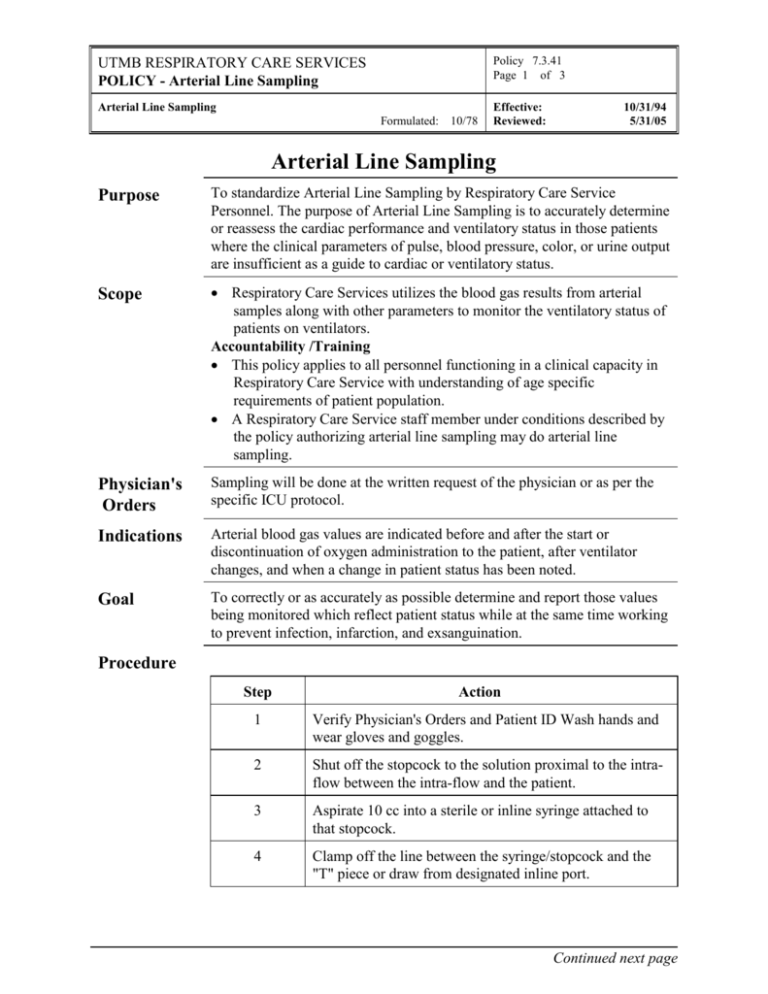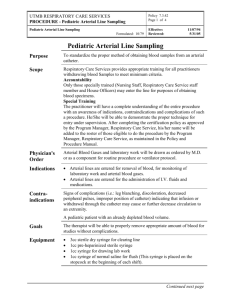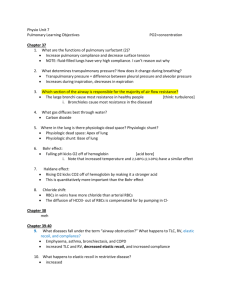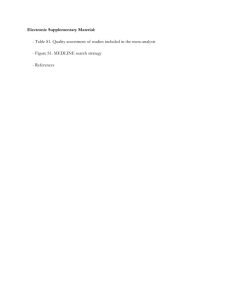Arterial Line Sampling
advertisement

Policy 7.3.41 Page 1 of 3 UTMB RESPIRATORY CARE SERVICES POLICY - Arterial Line Sampling Arterial Line Sampling Formulated: 10/78 Effective: Reviewed: 10/31/94 5/31/05 Arterial Line Sampling Purpose To standardize Arterial Line Sampling by Respiratory Care Service Personnel. The purpose of Arterial Line Sampling is to accurately determine or reassess the cardiac performance and ventilatory status in those patients where the clinical parameters of pulse, blood pressure, color, or urine output are insufficient as a guide to cardiac or ventilatory status. Scope Respiratory Care Services utilizes the blood gas results from arterial samples along with other parameters to monitor the ventilatory status of patients on ventilators. Accountability /Training This policy applies to all personnel functioning in a clinical capacity in Respiratory Care Service with understanding of age specific requirements of patient population. A Respiratory Care Service staff member under conditions described by the policy authorizing arterial line sampling may do arterial line sampling. Physician's Orders Sampling will be done at the written request of the physician or as per the specific ICU protocol. Indications Arterial blood gas values are indicated before and after the start or discontinuation of oxygen administration to the patient, after ventilator changes, and when a change in patient status has been noted. Goal To correctly or as accurately as possible determine and report those values being monitored which reflect patient status while at the same time working to prevent infection, infarction, and exsanguination. Procedure Step Action 1 Verify Physician's Orders and Patient ID Wash hands and wear gloves and goggles. 2 Shut off the stopcock to the solution proximal to the intraflow between the intra-flow and the patient. 3 Aspirate 10 cc into a sterile or inline syringe attached to that stopcock. 4 Clamp off the line between the syringe/stopcock and the "T" piece or draw from designated inline port. Continued next page Policy 7.3.41 Page 2 of 3 UTMB RESPIRATORY CARE SERVICES POLICY - Arterial Line Sampling Arterial Line Sampling Formulated: 10/78 Effective: Reviewed: 10/31/94 5/31/05 Procedure Continued Step 5 Swab the "T" piece with alcohol or Betadine. 6 Draw at least 1-3cc from the "T" piece or port with a sterile heparinized syringe. 7 Unclamp the line, and if less than 30 seconds, return the aspirate to line, insuring first that no air bubbles are being introduced into the system. To remove air bubbles, aspirate slightly, tap the syringe barrel, and allow the bubble to ascend up away from the stopcock, then return the aspirate to the system short of returning the air bubble. 8 Turn the stopcock open to system and flush the system briefly with solution through the intra-flow. 9 Properly label sample with the date, time, and conditions of ventilation, FIO2, patient temperature and tape the blood gas tag to the sample. Place on ice and/or send to Blood Gas Laboratory. 10 Complications of Arterial Lines Action Close off all open stopcocks with sterile syringes, tenckhoffs, or caps. Major Local obstruction with distal ischemia External hemorrhage False aneurysm Dissection Plaque dislodgement Cerebral infarction (carotid artery catheter) Renal shut down (femoral artery catheter) Sepsis Minor Pain Ecchymosis Temporary loss of pulse (arteriospasm) Local infarction Continued next page Policy 7.3.41 Page 3 of 3 UTMB RESPIRATORY CARE SERVICES POLICY - Arterial Line Sampling Arterial Line Sampling Formulated: Complications Continued 10/78 Effective: Reviewed: 10/31/94 5/31/05 Occlusion with ischemia Peripheral emboli Assessment of Outcome This procedure will be considered effective if it meets all of the above stated goals. Patient Teaching The patient should be informed of the purpose of the procedure to relieve apprehension. Infection Control/ Safety Precautions Documentation Document as outlined in Respiratory Care Services Policy & Procedure Manual Policies # 7.1.1 and # 7.1.2. Sterile equipment and technique will be used during set ups and change outs. Sterile technique will be used during care and operation around the site of insertion and at the equipment interfaces. Follow procedures as outlined Healthcare Epidemiology Policies and Procedures: #2.24 Respiratory Care Services. http://www.utmb.edu/policy/hcepidem/search/02-24.pdf AARC Clinical Practice Guidelines; Sampling For Arterial Blood Gas Analysis, Respiratory Care; 1992; 37:913-917 Haver VM, Eng W, Hussey JD, et al. Accuracy of electrolyte and blood gas determinations from samples collected in preheparinized syringes. Respiratory Care. 1996; 41:805-808. Shapiro, Peruzzi Kozelowski-Templin, Obtaining Blood Gas Samples, Clinical Application of Blood Gases 5th Edition Mosby-Year Book, Inc 1994 Martin C, Auffray JP, Badetti C, et al. Monitoring of central venous oxygen saturation versus mixed venous oxygen saturation in critically ill patients. Intensive Care Medicine. 1992; 18:101-4.








